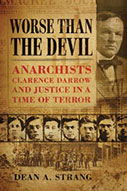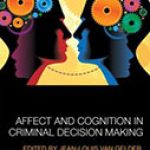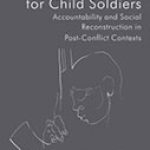Worse than the Devil: Anarchists, Clarence Darrow, and Justice in a Time of Terror

Author: Dean A. Strang
Publisher: Madison, WI: University of Wisconsin Press, 2013. 276p.
Reviewer: Peter Fenton | November 2014
On the evening of November 24, 1917, a bomb exploded inside the central police station in Milwaukee, Wisconsin. The blast killed nine police officers and a hapless civilian woman who had gone to the stationhouse to file a complaint. Many others were injured and sections of the building were destroyed. Dean A. Strang, the author of Worse than the Devil – Anarchists, Clarence Darrow, and Justice in a Time of Terror, notes that this was the single greatest loss of American law enforcement officers until the terrorist bombings of September 11, 2001.
Ironically, the Milwaukee Police Department was not the apparent target of those who made the bomb. It had originally been planted outside the Italian Evangelical Mission Church, a Protestant church run by a defrocked Catholic priest named Reverend August Giuliani. Via what can only be described as a tragedy of errors, the bomb was first discovered outside the church by a cleaning woman, who brought the suspicious package inside the church, where it remained all day. When police finally were called, they failed to respond promptly, so a church worker directed a young handyman to carry the device to the central police precinct. Inconceivably, police officers recognized the device as a bomb but kept it inside the building and moved it about for an hour while debate ensued on its proper disposal. All for naught; the device detonated at 7:24 pm, wreaking havoc on the police station and its occupants.
The authorities quickly focused their suspicions on a group of local Sicilian immigrants, ten men and a woman, who were believed to be anarchists, or socialists, or both. These poor, disenfranchised individuals were part of a larger group that had opposed the work of Rev. Giuliani and his flock because church members were staunchly Protestant and pro-America, supporting the entry of the United States into World War I. Prior to the bombing, there had been several angry street confrontations between the two factions, culminating in violence on September 9, 1917, in a section of Milwaukee known as Bay View. On that day, plainclothes police officers whose aid had been requested by Rev. Giuliani engaged in a gun battle with a group of suspected anarchists who had once again appeared at a Giuliani street rally. The exchange of gunfire left two detectives and two in the anarchist group wounded; two more of the Sicilian men were killed by police bullets. The aforementioned eleven suspected anarchists were promptly arrested and jailed by the police, charged with various offenses associated with the September 9th incident that came to be known as the Bay View Riot. These same people became the first and only suspects in the later bombing of the police station, despite the fact that all of them were still in custody at that time.
The focus of this short but well-written book is the trial of these eleven suspected Sicilian anarchists on charges related to the September encounter. No one was ever formally charged in connection with the bombing itself; nevertheless, the taint of suspicion was evident throughout the subsequent trial, and the police and prosecutor took every opportunity to imply that these defendants, however improbably, were the ones responsible for the murders of nine police officers and an innocent bystander.
The majority of this book is a detailed description of the grim and shocking injustices inflicted upon the suspects, as the xenophobia that swept the United States on the eve of its entry into World War I came to bear on them. The author succeeds at painting a vivid picture of the climate of fear and anti-immigrant sentiment rampant throughout a nation built by immigrants and their children. Local newspapers reported gleefully about the “third degree” tactics used by Milwaukee police in the course of their perfunctory investigation prior to trial. It is notable that, at the time of this incident, not a single Milwaukee police officer spoke Italian; detectives from Chicago who were conversant in the suspects’ native tongue were summoned to spend a few days assisting the Milwaukee officers. Their primary role was to serve as interpreters during interrogations by the Milwaukee detectives.
A second fascinating aspect of this book is the depiction of the complexity of the attorneys involved in the trial and ultimate appeal, both as individuals and as persons fulfilling their respective roles in the judicial process. District Attorney Winfred C. Zabel was himself an immigrant from Germany. He was a member of the Social Democrat Party, and ran for the office of District Attorney on a platform of reform. Prior to the trial of the Sicilian suspects, he was most known for successfully advocating for commitment rather than criminal prosecution of a mentally disturbed man who had shot and wounded former President Theodore Roosevelt during a 1912 public appearance in Milwaukee. This was a particularly courageous position for a politician to take, given the climate of the times and the popularity of the former President. Primary defense attorney William B. Rubin was also an immigrant from a Russian family who came to America when he was nine years old. Rubin built his reputation as a lawyer for organized labor, although his criminal practice was thriving as well at the time of the Bay View incident. The trial judge, August C. Backus, was only forty years of age when he took the bench to preside over the heated courtroom battle that ensued between Zabel and Rubin.
Author Strang’s painstaking account of the progress of the trial of the Bay View defendants reveals a shocking multiplicity of injustices. Throughout the trial, Prosecutor Zabel made reference to the defendants’ involvement in the Milwaukee police station bombing. Tainted incriminating statements and hearsay evidence were routinely admitted by Judge Backus over Bill Rubin’s objections. Defense Counsel Rubin was allowed to represent ten of the eleven defendants, despite the obvious potential for a conflict of interest, and all eleven were tried jointly, allowing prosecutor Zabel to exploit his conspiracy theory. Some of Rubin’s objections and motions were simply ignored by the Court, denying the defense a basis for subsequent appeal. Alleged anarchist literature, seized from a local Sicilian social club, was admitted into evidence as proof of the defendants’ anarchist, anti-American sympathies. Most astonishing, perhaps, is the selection by Judge Backus of the person who served as interpreter for the defendants, all of whom spoke little or no English. That role was assigned to August Giuliani, the very minister whose church was the actual target of the November bombing and the nemesis of the accused. In the absence of any procedural safeguards that modern lawyers and judges take for granted, it is no surprise that all eleven defendants were convicted by the jury of all charges related to the Bay View incident and were each sentenced by Judge Backus to twenty-five years in prison, with no consideration given to the level of participation in or culpability for the riot.
Although his name appears prominently in the title, Clarence Darrow does not appear until three-quarters of the way through Worse than the Devil – Anarchists, Clarence Darrow, and Justice in a Time of Terror, when he is brought in to handle the appeals for the Bay View defendants. One of America’s most famous and most controversial trial lawyers, Darrow had just a few years earlier defeated efforts by a prosecutor in Los Angeles to convict him of jury tampering. Like Bill Rubin, Darrow built his reputation originally as a lawyer for the unions, but later took on notable criminal cases. Although there is no definitive evidence, the author of this book speculates convincingly that Emma Goldman and other prominent American socialists raised the money to retain Darrow to handle the appeal on behalf of the Sicilians convicted in Milwaukee.
Ultimately, Darrow’s efforts on the appeal were mostly successful; the convictions of nine of the eleven defendants were reversed by the Wisconsin Supreme Court. Then, almost two years later, Clarence Darrow submitted to Wisconsin Governor John J. Blaine a petition to pardon the two Sicilians whose convictions had been affirmed. Strangely, that petition was followed by a letter of support signed by both Winfred Zabel and Judge Backus. Governor Blaine pardoned the two remaining Bay View defendants only after receiving assurances that they would be promptly deported.
It is during and after the appeals process that the relationships among the major players in this case become convoluted and enigmatic. We learn that, despite their acrimonious exchanges during the Bay View trial, complete with cross-allegations of incompetence and corruption, Winfred Zabel and William Rubin practiced law together in the years before and after. During the remainder of his tenure as District Attorney, Zabel would be accused of accepting bribes and engaging in shady business deals. He and his chief assistant both received death threats following the Bay View convictions. Clarence Darrow himself would never completely shake off the taint of corruption.
The author of this book is an able wordsmith whose vivid descriptions bring the characters in this century-old drama to life. Winfred Zabel’s visage is described as, “… sharp – not hard, but intricately carved….” Bill Rubin is said to have “… retained a boyish, mischievous look. He was putty-sculpted about right to be a criminal defense lawyer.” A number of photographs accompany the text, further serving to give the reader insight about the persons and places in this story. As the meticulous footnotes reveal, Dean Strang’s extensive research included reviews of available trial transcripts and news accounts of the police station bombing and the trial, as well as biographical information about all the major participants in the trial and appeal. A criminal defense attorney himself, Mr. Strang supports his narrative with clear, concise explanations of processes by which trials and appeals are conducted.
Anyone with an interest in American history, political science, or law will derive substantial benefit and pleasure from reading Worse than the Devil – Anarchists, Clarence Darrow, and Justice in a Time of Terror. This intriguing and comprehensive account of a little-known but significant episode in American history and jurisprudence provides valuable lessons on how our nation and its institutions have traditionally responded to individuals and groups, however minuscule or marginal, that are perceived as threats to our way of life. Much can be learned from this small but significant book about our twenty-first century concepts of justice in our current “time of terror.”
Peter W. Fenton, JD, Assistant Professor of Criminal Justice Kennesaw State University, Kennesaw, GA


